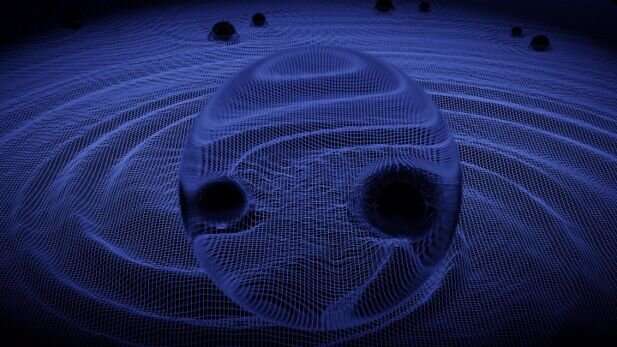Artistic impression of lensed gravitational waves, Riccardo Buscicchio (University of Birmingham)
Scientists searching for evidence of lensed gravitational waves have published new research outlining the most recent findings on their quest for the first detection of these elusive signals.
Gravitational lensing has been predicted by Einstein himself, and observed by scientists for decades: light emitted by distant objects in the Universe is bent by the gravitational pull of very massive galaxies, as they cross the line-of-sight of the light source. Sometimes the pull is so strong that two copies of the same source can appear in the sky.
It has been known since the late 1970s the same would happen for gravitational waves. If a lensed gravitational wave were to be detected it would open up avenues for exploring new physics, by unlocking precision cosmology and offering new ways of testing Einstein's general relativity.
However, these effects are extremely hard to detect: if gravitationally lensed light is a 4-leaf clover, a lensed gravitational wave is a needle in a thousand haystacks. Last year, the team in the University's School of Physics and Astronomy and the Institute for Gravitational Wave Astronomy had predicted that these elusive signals were unlikely to be observed by instruments currently operated by the LIGO and Virgo Collaborations. A paper was published in Physical Review Letters , soon followed by a follow-up study in Physical Reviews D.
The methodology developed at the University of Birmingham for quantifying how frequently gravitational wave lensing occurs has now been extensively vetted by the LIGO/Virgo/KAGRA collaboration, and included in a flagship study using most recent detections, published this week on arXiv.
"Here we are, on the second episode of the hunt for lensed gravitational waves, and we are hooked for the finale." says Riccardo Buscicchio, Ph.D. student at the University of Birmingham and a member of the LIGO-Virgo-KAGRA collaboration. "The new collaboration results are in agreement with our previous expectations. The more sensitive the instruments become, the deeper we can look in the distant Universe, the sooner we will find the needle. The constant humming background of faint distant sources already give us some hints of when it could happen."
The study, looking for additional signatures of lensing, includes detailed analyses of other possible effects like microlensing or double images. Riccardo adds: "While no compelling evidence has been found so far, with multiple detectors coming up online in the next decade or so, the prospects are exciting."
More information: Search for lensing signatures in the gravitational-wave observations from the first half of LIGO-Virgo's third observing run. arxiv.org/abs/2105.06384 arXiv:2105.06384v1 [gr-qc]
Riccardo Buscicchio et al. Constraining the Lensing of Binary Black Holes from Their Stochastic Background, Physical Review Letters (2020). DOI: 10.1103/PhysRevLett.125.141102
Riccardo Buscicchio et al. Constraining the lensing of binary neutron stars from their stochastic background, Physical Review D (2020). DOI: 10.1103/PhysRevD.102.081501
Journal information: Physical Review Letters , Physical Review D
Provided by University of Birmingham
























